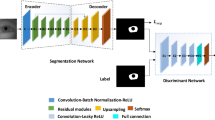Abstract
In recent years, iris recognition has been widely used in various fields. As the first step of iris recognition, segmentation accuracy is of great significance to the final recognition. However, iris images exhibit a variety of noise in the real world, which leads to lower segmentation accuracy than the ideal case. To address this problem, this paper proposes an iris segmentation method using feature channel optimization for noisy images. The method for non-ideal environments with noise is more suitable for practical applications. We add dense blocks and dilated convolutional layers to the encoder so that the information gradient flow obtained by different layers can be reused, and the receptive field can be expanded. In the decoder, based on Jensen-Shannon (JS) divergence, we first recalculate the weight of the feature channels obtained from each layer, which enhances the useful information and suppresses the interference information in the noisy environments to boost the segmentation accuracy. The proposed architecture is validated in the CASIA v4.0 interval (CASIA) and IIT Delhi v1.0 datasets (IITD). For CASIA, the mean error rate is 0.78%, and the F-measure value is 98.21%. For IITD, the mean error rate is 0.97%, and the F-measure value is 97.87%. Experimental results show that the proposed method outperforms other state-of-art methods under noisy environments, such as Gaussian blur, Gaussian noise, and salt and pepper noise.





Similar content being viewed by others
Notes
The code is available at https://github.com/wowotou1022/IrisSegment.
References
Wildes RP. Iris recognition: an emerging biometric technology. Proc IEEE 1997;85(9):1348–1363.
Albadarneh A, Albadarneh I, Alqatawna J. Iris recognition system for secure authentication based on texture and shape features. IEEE jordan conference on applied electrical engineering and computing technologies (AEECT). IEEE, 2015; 2015. p. 1–6.
Gao C, Feng G, Ren Y, Liu L. Iris segmentation based on improved u-net network model. IEICE Transactions on Fundamentals of Electronics. Commun Comput Sci 2019;102(8):982–985.
Ronneberger O, Fischer P, Brox T. U-net: convolutional networks for biomedical image segmentation. International conference on medical image computing and computer-assisted intervention. New York: Springer; 2015. p. 234–241.
Yu F, Koltun V. 2015. Multi-scale context aggregation by dilated convolutions arXiv:151107122.
CASIA Iris Interval Database. 2017. http://biometrics.idealtest.org/dbDetailForUser.do?id=4. Accessed December 28.
Iit Delhi Iris Database. 2017. http://www4.comp.polyu.edu.hk/csajaykr/IITD/Database_Iris.htm. Accessed December 28.
Liu N, Li H, Zhang M, Liu J, Sun Z, Tan T. Accurate iris segmentation in non-cooperative environments using fully convolutional networks. International conference on biometrics (ICB). IEEE, 2016; 2016. p. 1–8.
Masek L, et al. 2003. Recognition of human iris patterns for biometric identification. Ph.D. thesis, Master’s thesis University of Western Australia.
Arvacheh EM, Tizhoosh HR. Iris segmentation: Detecting pupil, limbus and eyelids. 2006 International Conference on Image Processing, IEEE; 2006. p. 2453–2456.
Koh J, Govindaraju V, Chaudhary V. A robust iris localization method using an active contour model and hough transform. 2010 20th international conference on pattern recognition. IEEE; 2010. p. 2852–2856.
Okokpujie K, Noma-Osaghae E, John S, Ajulibe A. An improved iris segmentation technique using circular hough transform. IT Convergence and Security 2017. New York: Springer; 2018. p. 203–211.
Tan CW, Kumar A. Towards online iris and periocular recognition under relaxed imaging constraints. IEEE Trans Image Process 2013;22(10):3751–3765.
Tan T, He Z, Sun Z. Efficient and robust segmentation of noisy iris images for non-cooperative iris recognition. Image and vision computing 2010;28(2):223–230.
Long J, Shelhamer E, Darrell T. Fully convolutional networks for semantic segmentation. Proceedings of the IEEE conference on computer vision and pattern recognition; 2015. p. 3431–3440.
Lian S, Luo Z, Zhong Z, Lin X, Su S, Li S. Attention guided u-net for accurate iris segmentation. J Vis Commun Image Represent 2018;56:296–304.
Lakra A, Tripathi P, Keshari R, Vatsa M, Singh R. Segdensenet: Iris segmentation for pre-and-post cataract surgery. 2018 24th international conference on pattern recognition (ICPR). IEEE; 2018. p. 3150–3155.
Huang G, Liu Z, Van Der Maaten L, Weinberger KQ. Densely connected convolutional networks. Proceedings of the IEEE conference on computer vision and pattern recognition; 2017. p. 4700–4708.
Arsalan M, Naqvi R, Kim D, Nguyen P, Owais M, Park K. Irisdensenet: Robust iris segmentation using densely connected fully convolutional networks in the images by visible light and near-infrared light camera sensors. Sensors 2018;18(5):1501.
Badrinarayanan V, Kendall A, Cipolla R. Segnet: a deep convolutional encoder-decoder architecture for image segmentation. IEEE Trans Pattern Anal Mach Intell 2017;39(12):2481–2495.
Hu J, Shen L, Sun G. Squeeze-and-excitation networks. Proceedings of the IEEE conference on computer vision and pattern recognition; 2018. p. 7132–7141.
Luong MT, Pham H, Manning CD. 2015. Effective approaches to attention-based neural machine translation arXiv:150804025.
Kingma DP, Ba J. 2014. Adam: a method for stochastic optimization arXiv:14126980.
Chollet F, Keras. 2015. https://github.com/keras-team/keras Accessed.
Nice I. 2018. Noisy iris challenge evaluation-part i. http://nice1.di.ubi.pt/. Accessed January 4.
Acknowledgments
The authors are grateful to the reviewers for their valuable comments.
Funding
This work was supported in part by the National Natural Science Foundation of China under Grants U1736120, 61525203, U1636206, U1936214 and Natural Science Foundation of Shanghai under Grant 19ZR1419000.
Author information
Authors and Affiliations
Corresponding author
Ethics declarations
Conflict of Interest
The authors declare that they have no conflict of interest.
Additional information
Publisher’s Note
Springer Nature remains neutral with regard to jurisdictional claims in published maps and institutional affiliations.
Ethical Approval
This article does not contain any studies with human participants or animals performed by any of the authors.
Rights and permissions
About this article
Cite this article
Hao, K., Feng, G., Ren, Y. et al. Iris Segmentation Using Feature Channel Optimization for Noisy Environments. Cogn Comput 12, 1205–1216 (2020). https://doi.org/10.1007/s12559-020-09759-9
Received:
Accepted:
Published:
Issue Date:
DOI: https://doi.org/10.1007/s12559-020-09759-9




